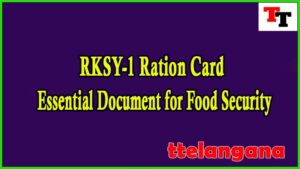Ration Card – An Essential Document for Food Security
Introduction: A ration card is a vital document issued by the government to eligible individuals or families, enabling them to purchase essential commodities at subsidized rates from designated fair price shops. It serves as a tool to ensure food security and prevent hunger among vulnerable sections of society. In this article, we will explore the significance of the Ration Card Scheme in India, its types, benefits, and the process of obtaining and using a ration card.
- History of Ration Card: The concept of rationing dates back to the World War II era when countries faced shortages of essential goods. In India, rationing was introduced in the early 1940s to combat scarcity during the war. The ration card system was established to distribute limited supplies of food and other essential items fairly among the population. Over time, the system evolved, and today, it plays a crucial role in ensuring food security and poverty alleviation.
- Types of Ration Cards: Ration cards in India are categorized into three types: Above Poverty Line (APL) cards, Below Poverty Line (BPL) cards, and Antyodaya Anna Yojana (AAY) cards. APL cards are issued to families not falling under the poverty line, while BPL cards are given to economically weaker sections. AAY cards are specifically for the poorest of the poor, providing additional benefits and priority in the allocation of food grains.
- Eligibility and Application Process: To obtain a ration card, individuals must fulfill certain eligibility criteria, including income limits, family size, and citizenship status. The application process varies from state to state but generally involves submitting the required documents, such as proof of identity, address, and income. The application is then verified by the authorities, and upon successful verification, the ration card is issued.
- Benefits of Ration Card: The ration card serves multiple purposes, with its primary objective being food security. It ensures that eligible individuals and families have access to essential commodities such as rice, wheat, sugar, pulses, and kerosene at subsidized rates. The scheme also helps in poverty alleviation by reducing the financial burden on low-income households and preventing them from falling into the cycle of debt or malnutrition.

- Digitalization of Ration Cards: In recent years, several states in India have undertaken the digitalization of ration cards. This initiative aims to streamline the distribution process, eliminate fraud, and enhance transparency. Digital ration cards, often linked to Aadhaar (a unique identification number), enable beneficiaries to avail themselves of their entitlements more efficiently. They also facilitate the direct transfer of subsidies, eliminating intermediaries and reducing leakages.
- Challenges and Reforms: While the ration card system has made significant contributions to food security, it faces certain challenges. Issues like corruption, fake cards, and inadequate coverage of deserving beneficiaries hinder its effectiveness. To address these concerns, the government has introduced various reforms such as the One Nation One Ration Card scheme, which allows portability of ration cards across states, and the use of technology to monitor and plug leakages in the distribution system.
- Future Prospects: As India moves forward, there is a need for continuous improvement in the ration card system. Strengthening the infrastructure, ensuring transparent governance, and expanding the coverage of beneficiaries are essential steps. Additionally, exploring innovative approaches like targeted subsidies and integrating the ration card system with other welfare schemes can further enhance its impact on poverty eradication and social development.
Conclusion: The ration card system in India has played a pivotal role in addressing food insecurity and reducing poverty among vulnerable sections of society. It has provided millions of households with access to affordable food grains and essential commodities. However, continuous efforts are required to overcome challenges and strengthen the system further. By ensuring transparency, implementing reforms, and leveraging technology, the ration card scheme can continue to be a powerful tool in promoting food security and social welfare in the country.